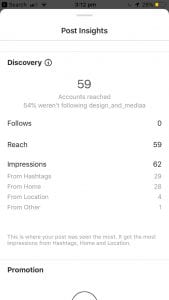1. How did you author (the photo or video) you recorded for upload to Instagram?
For this week, I decided to do all the authoring process through my Iphone 6 camera. As I did with the last post, I follow the theme I settle on for my account, Beauty and Hygiene products that are practical to travel with, focusing on how the redesign can expand and item usability. I used the rear view to take the photo of my perfumes, and took two different shots, one with the flash on and one with the flash off, to see which looked better. I didn’t zoom in because I placed the objects on my hand, so the camera was already close to it.
Once I decided which picture looked better, I proceeded to do the editing only using what the integrated iphone camera application offered. I centered the photo and changed it to square format, used the “enhance” feature and put a filter called “dramatic cool”. With so many modifying options, I started to alter the light and colour to the photo without really knowing if I was making it look better or worse.
With the rise of Instagram as a form of visual aesthetic, I found myself trying to edit the photo to look like the professional ones that I see on my feed, without considering what I style I actually prefer or find pretty or if I really know what I’m doing with all the changes I apply in the editing process. Tama Leaver et al. explains this in the book Instagram: Visual Social Media Cultures. They said that everyday is more common to see “templates” of Instagram photos, a specific formula that will make your post likeable to most people (2020, p.164).
This practice became massive with the popularization of Instagram as a networked platform. Before that, photography was mostly relegated to professional practitioners who try to differentiate themselves with the other photographers and put more emphasis on the act of finding “the decisive moment”, as Henri Carter-Bresson did.
2. How did you publish (the photo or video) you recorded for upload to Instagram?
As I mentioned before, I took two photos of the products I wanted to share, with and without flash, and finally chose the one without flash because It looked least saturated. However, before shooting the pictures, I practice different positions and backgrounds to find the image I wanted to portray, an “Instagram-worthy” post.
Once I finish editing the photo on my phone, I proceed to go through the publishing process on the social platform. For the caption, I followed the advice I took last week and wrote a description that was friendly, short and could grab the viewer’s attention: “What is more practical than @poloralphlauren travel size perfumes? The perfect combination between design and beauty”. In addition to that, I put the hashtags “#makeuptutorial #skincare #perfume #ralphlauren #melbourne #australia #makeup #polo1 #polo3”, to go with the theme of my account.
Lev Manovich talks about how these subcultures, as the beauty world I’m trying to get into, and explains that the affordances the platform allows with its features, help the growth and establishment of different niches (Manovich 2016)
3. How did you distribute (the photo or video) you published on Instagram to other social media services?

During the publishing process on Instagram, I shared the post into my Tumblr and Twitter account at the same time I did on the photo sharing app. I decided to use the same geotag, Melbourne, Victoria, Australia, and because last week I got great results, I use similar hashtags: #makeuptutorial #skincare #perfume #ralphlauren #melbourne #australia #makeup #polo1 #polo3. I once again follow the advice of including a mix of tags with low, medium and high amount of followers and use ones that relate to the topic I was showing. In addition to that, I tagged the brand of the item In the photo to look more professional and appear in their profile, however, I later realized I had to tag them in the photo itself and not just in the caption to pop up in their account.
Thanks to the business features of Instagram, I’m able to see how well my photo did in terms of visibility and interactions, “the analytics feature called Insights shows top posts, reach, impressions and engagement around posts, along with data on followers like their gender, age and location” (Manovich 2016, pp.134). According to that information, to this date, My post has reached 59 people and has 62 impressions. Between that last portion of data, 29 impressions were thanks to the hashtags I used and four had relation with the location I put. Besides that, the photo got 10 likes, being the most successful of the three weeks.
In regards to the other platforms, the picture didn’t have the same reach and only had one like on Tumblr. This made me think of the differences the softwares might have and that every platform has a distinct dynamic that represents how each community functions, with their own norms and interactions.


References
– Leaver, T, Highfield, T, Abidin, C, YP 2020, ‘From the Instagram of Everything to Everything of Instagram’, in Instagram: Visual Social Media Cultures. Digital Media and Society, Cambridge, United Kingdom, pp. 150-165.
– Manovich, L. 2016, ‘Part 3. Instagramism’ & ‘Part 4. Themes, Feeds, Sequences, Branding, Faces, Bodies’, Instagram and the Contemporary Image, University of San Diego, USA., pp. 71-137.